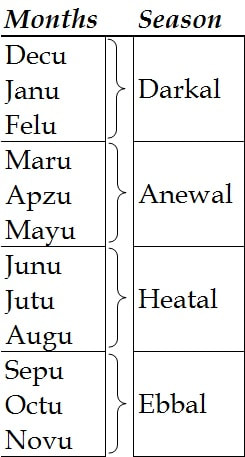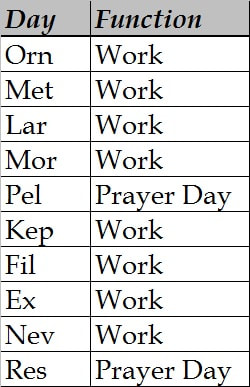Thran's Monthly Calendar- 12 Months & 360 days in a year
- 30 Days in each month - 3 "Ten Days" per month - 1 Prayer Day every five days Gods play an integral and tangible role for the inhabitants of Thran, even granting their most dedicated followers powerful spells, but with such an intimate relationship, comes an added level of devotion. All that is required are a few moments of prayer on the holy/unholy day, but established temples will offer more intricate services for their followers on each Prayer Day. Check out the different deities: Good, Neutral, Evil
|
Author's Comment on Calendar Systems
We all go through our lives with such a natural understanding of months, days, and time itself, that we really don't have to spend any time 'thinking' about information presented to us. If I told you, "I went swimming in January, in Minnesota", you already know, without any additional info, that it must have been very cold, and either I am crazy, or it was an indoor pool. Think of how much additional explanation and, wasted time (and space, for a novel), it would have taken to put that statement into a meaningful context, if you had no idea what January was. I'd have to give you more specifics about the location and actual environmental conditions - and not only for that month, but all the months. Rather than discard all that inherent knowledge, I decided to take the well known Gregorian calendar and give it a slight twist...making it unique and different, but still definitely familiar.
To accomplish that goal, I took the three letter abbreviation for each month and added a 'u' onto the end of it: January = Jan = Janu. Therefore, most people, in the northern hemisphere anyway, would have an innate understanding that Janu would be a cold, wintry (Darkal), month.
With the months already being familiar, I took a little more liberty with the seasons, but still gave them a marginally literal name: Darkal = Winter, Anewal = Spring, Heatal = Summer, and Ebbal= Fall. Again, I am trying to make the language accessible and the message easy to convey.
365.25 days in a year, although normal to us in the real world, is a little more complicated than necessary, and when I was gaming back int he 80's and 90's, I used a 10 day week, so I just adopted it for Thran. Why the 'Prayer Days'? Because the gods play such a tangible role in the world, with the spells they provide and their interaction with mortals, it is logical that there should be frequent days set aside, or at least time on those days, to pay homage. In order to maintain the natural pace of time and the seasons, I decided on 30 day months, which, of course, equates to 360 days per year.
Mission accomplished. Simple, easy to understand, familiar, yet still different enough.
-Brian McLaughlin
To accomplish that goal, I took the three letter abbreviation for each month and added a 'u' onto the end of it: January = Jan = Janu. Therefore, most people, in the northern hemisphere anyway, would have an innate understanding that Janu would be a cold, wintry (Darkal), month.
With the months already being familiar, I took a little more liberty with the seasons, but still gave them a marginally literal name: Darkal = Winter, Anewal = Spring, Heatal = Summer, and Ebbal= Fall. Again, I am trying to make the language accessible and the message easy to convey.
365.25 days in a year, although normal to us in the real world, is a little more complicated than necessary, and when I was gaming back int he 80's and 90's, I used a 10 day week, so I just adopted it for Thran. Why the 'Prayer Days'? Because the gods play such a tangible role in the world, with the spells they provide and their interaction with mortals, it is logical that there should be frequent days set aside, or at least time on those days, to pay homage. In order to maintain the natural pace of time and the seasons, I decided on 30 day months, which, of course, equates to 360 days per year.
Mission accomplished. Simple, easy to understand, familiar, yet still different enough.
-Brian McLaughlin

